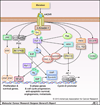Nicotine-mediated cell proliferation and tumor progression in smoking-related cancers
- PMID: 24398389
- PMCID: PMC3915512
- DOI: 10.1158/1541-7786.MCR-13-0541
Nicotine-mediated cell proliferation and tumor progression in smoking-related cancers
Abstract
Tobacco smoke contains multiple classes of established carcinogens including benzo(a)pyrenes, polycyclic aromatic hydrocarbons, and tobacco-specific nitrosamines. Most of these compounds exert their genotoxic effects by forming DNA adducts and generation of reactive oxygen species, causing mutations in vital genes such as K-Ras and p53. In addition, tobacco-specific nitrosamines can activate nicotinic acetylcholine receptors (nAChR) and to a certain extent β-adrenergic receptors (β-AR), promoting cell proliferation. Furthermore, it has been demonstrated that nicotine, the major addictive component of tobacco smoke, can induce cell-cycle progression, angiogenesis, and metastasis of lung and pancreatic cancers. These effects occur mainly through the α7-nAChRs, with possible contribution from the β-ARs and/or epidermal growth factor receptors. This review article will discuss the molecular mechanisms by which nicotine and its oncogenic derivatives such as 4-(methylnitrosamino)-1-(3-pyridyl)-1-butanone and N-nitrosonornicotine induce cell-cycle progression and promote tumor growth. A variety of signaling cascades are induced by nicotine through nAChRs, including the mitogen-activated protein kinase/extracellular signal-regulated kinase pathway, phosphoinositide 3-kinase/AKT pathway, and janus-activated kinase/STAT signaling. In addition, studies have shown that nAChR activation induces Src kinase in a β-arrestin-1-dependent manner, leading to the inactivation of Rb protein and resulting in the expression of E2F1-regulated proliferative genes. Such nAChR-mediated signaling events enhance the proliferation of cells and render them resistant to apoptosis induced by various agents. These observations highlight the role of nAChRs in promoting the growth and metastasis of tumors and raise the possibility of targeting them for cancer therapy.
©2014 AACR.
Figures


References
-
- Siegel R, Naishadham D, Jemal A. Cancer statistics, 2013. CA: a cancer journal for clinicians. 2013;63:11–30. - PubMed
-
- Hecht SS. Tobacco carcinogens, their biomarkers and tobacco-induced cancer. Nat Rev Cancer. 2003;3:733–744. - PubMed
-
- Hecht SS. Tobacco smoke carcinogens and lung cancer. J Natl Cancer Inst. 1999;91:1194–1210. - PubMed
-
- Phillips DH. Smoking-related DNA and protein adducts in human tissues. Carcinogenesis. 2002;23:1979–2004. - PubMed
Publication types
MeSH terms
Substances
Grants and funding
LinkOut - more resources
Full Text Sources
Other Literature Sources
Medical
Research Materials
Miscellaneous

